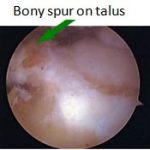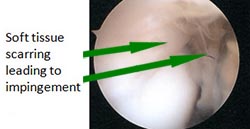What will the surgery involve?
i. Anaesthetic – usually a general anaesthetic is required; local anaesthetic will be injected around the incisions at the end of the operation to reduce the pain. You will have a chance to discuss your anaesthetic with the anaesthetist before the operation.
ii. Incisions – two small incisions on the front of the ankle:
one on the inside
one on the outside
possibly one at the back of the ankle

Fig 1. Anteromedial impingement
iii. The surgery – Your ankle will be inspected through the ’arthroscope’ (telescope) and any cartilage problems, scar tissue and bony bumps will be treated appropriately.
iv. Stitches – Removable, non-dissolving sutures will be used to close the skin. These will be removed at your appointment about two weeks after surgery.
v. Dressings – Special dressings will be placed on the ankle that should be left in place until you are reviewed in the clinic.
What happens after the surgery?
i. Going home – This will either be the same day or the following morning depending on the time of surgery and home situation.
ii. Pain relief – The local anaesthetic ankle should provide some pain relief, but you will be supplied with pain relieving tablets by the hospital (usually co-codamol and tramadol) these should be taken regularly initially. You can gradually reduce these as your pain allows (tramadol is the stronger pain killer).

Fig 2. Anterolateral soft tissue impingement
You will find it more comfortable to keep your foot up on a chair, if possible above the level of your heart, as much as you can for the first two weeks after surgery. This will help reduce the swelling and therefore also help wound healing.
iii. Walking – If your problem is cartilage damage then the plan will be:
– non-weight bearing for about 2-4 weeks after surgery (I will inform you of the exact length of time)
– then normal walking for 6 weeks
– then easy jogging for 4 weeks
– then non contact sports for 4 weeks
– then back to full activity
If your arthroscopy is for another reason then plan will be:
– weight bearing with crutches for 2 weeks
– then normal walking for 4 weeks
– then easy jogging for 4 weeks
– then non contact sports for 4 weeks
– then back to full activity
iv. Exercises – You should exercise the ankle from the day of surgery
– bend the ankle up to a right angle slowly 2-3 times per hour for the first two days increase the frequency with which you do this exercise over the next two weeks this will help reduce the chance of excessive scar tissue building up
– avoid circular movements for two weeks
– after two weeks you will be seen by a physiotherapist who will guide you through further rehabilitation
iv. Driving – You will not be able to drive until you can walk without crutches confidently. If you the surgery is on your left foot and you have an automatic car you may be able to drive after your two week review, but you should check with your insurance company first.
v. Follow up – You will be seen in the outpatient clinic two weeks after surgery when your sutures will be removed. Further follow up will depend on the exact surgery undertaken.
v. Return to work – This will depend on whether you had cartilage surgery or not. Approximately:
Without cartilage surgery:
Office job – 2 weeks
Mobile job requiring driving – 3 – 4 weeks
Manual labour – 6 weeks
With cartilage surgery
Office job – 2 weeks
Mobile job requiring walking – 4 – 6 weeks
Manual labour – 8 – 10 weeks
What are the risks of the operation?
There are a small number of risks of surgery including infection, nerve damage, blood clots, ongoing pain and the need for further surgery (please see General Risks of Foot and Ankle Surgery for further information)
